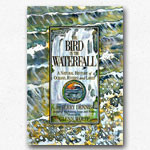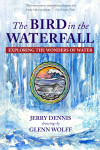(January, Cathead Point, near the tip of Michigan’s Leelanau Peninsula)
IT CHANGES EVERY MOMENT. It’s a thousand lakes, changing faces with every shift in wind and light – flurried by offshore wind, white-capped in squalls, colored flannel gray or pearl white or stormy black beneath the winter clouds, a dozen blues when the sky is blue.
There’s a contemporary Japanese poet who writes a diary on a slab of stone instead of paper, with water instead of ink. He writes a word, and a moment later it evaporates. This, he suggests, is the true record of a life.
*
We go to the shore in search of elemental things. Probably it’s just coincidence that the elemental things we find there—sand, sun, wind, and waves—correspond exactly to the four elements of the ancient Greeks and Hindus—earth, fire, air, and water. More to the point is that we need elemental things to keep our primitive senses in working condition. We need periodically to look, listen, scent, taste, and feel our way through the world, if only for the relief of not having to think our way through.
It’s not always an easy task. Time coats us in natural increase, accruing layers as if we were snowballs rolling down a hill. Jobs, families, friends, houses, cars, dogs, our health– just maintaining it all is full-time work. Add the bulging files of information, the gunnysacks of mistakes and the duffels of misjudgments and the barrow-loads of memories, habits, regrets, opinions, prejudices, principles, laws, and codes collected in a lifetime, and you can see the problem. We carry as much as we can, and the rest we stack around us until all our routes to the outside are blocked. Even when we find our way out we’re wearing too many layers of tuxedoes and zoot suits and cardigans, Icelandic woolens, parkas, longjohns, thermal socks, etc. We’re strong but we grow weary of lugging that Collyer-brothers’ accumulation everywhere we go. We bend beneath the load, our backs about to break, groaning as we push our heaped-up grocery carts through the streets.
It’s too much. Now and then we need to strip down to the naked flame at our core so we can remember what it feels like to be alive. Most of what we carry is baggage anyway—just adornment and vanity, ballast and deadweight. It’s the crap the pioneers threw out along the Oregon Trail.
*
After lunch I walked to the crest of the dune and looked out at the lake. Even from that small elevation, maybe fifty feet, the water’s clarity was startling. From a boat, on a day like this, with the sun overhead, you can lean over the side and see boulders on the bottom thirty feet down.
The pale shallows stepped into blue depths. The offshore sandbars were there, a hundred yards apart, each deeper than the one before, with bands of increasingly darker blue between them. Beyond the last bar a steep drop-off into very deep water turned the water midnight blue.
Lake Michigan. My lake, I often think, because I grew up near it and because so many in my family settled along its shores. So much water, in a body so large they say that the Netherlands could fit inside, with enough room left over for several New England states. It is the second largest of the Great Lakes in volume, and third, after Superior and Huron, in surface area. It is the only one of the five to be contained entirely within the United States.
Most of the 1,640 miles of shore is sandy. Some of that shore, especially around the southern end, through Indiana and Illinois, is lined with industry. Around the top of the lake in Wisconsin and Michigan are limestone bluffs and rocky strands. But most of the rest is blond sand beaches that are among the loveliest in North America. Wind, waves, and ice have shoved that sand into the most extensive network of freshwater dunes on the planet. They reach their apogee about thirty miles south of Cathead Point at Sleeping Bear Dunes —the most beautiful place in America, according to “Good Morning, America,” and I don’t disagree—but they extend nearly unbroken for three hundred miles along the eastern and southern shores of the lake, from northern Michigan nearly to Chicago. A few scattered dunes are found also along the Wisconsin shore and at the top of the lake, in the Upper Peninsula of Michigan, but they lack the dimensions of those that face the prevailing winds.
A friend who lives part of every year in the West once told me that Lake Michigan plays the same role in the Midwest that the mountains do in Montana. That’s true for all five lakes. Like the Rockies, you can see them from miles away, forming a backdrop that is also a felt presence, always there, looming in our lives. They are depositories of geological and historical power that shape the land and the culture to themselves. We orient to them and are drawn to them and take for granted that their presence and the weather they create will affect our travels and alter our daily plans.
The lakes have always been the most prominent shaper of the character or “spirit of the Great Lakes region. The stronger the spirit of a place, the farther it resonates beyond its borders. Alaska, Texas, Vermont, and Maine all have it in abundance. So do large geographical regions such as Appalachia, the Canadian Maritimes, and the swamplands of Louisiana. A mythological portrait of a place needs to be only approximately accurate to give outsiders an idea of what it is like, or enough of an idea, anyway, to inspire interest in it. That might explain in part why people who have never visited the Everglades or the Arctic Wildlife Refuge are willing to write letters to congressmen and donate money to protect them.
The Great Lakes have not had that advantage. Their mythology is not clearly defined. It was once very clear, a living mythology, inhabited by people, wolf, moose, and bear, but the stories that passed around campfires for thousands of years were drowned out by European invaders wielding their own stories of Jesuit martyrs, French voyageurs, Paul Bunyans of the logging camps, mariners of the inland seas, and up-by-the-bootstraps giants of industry. Most of those stories have now, in turn, lost their power and have not been replaced. Enduring mythologies tend to accrue to dominate features of a landscape. Louisiana has swamps; New England, hardscrabble hills; Montana, big sky. But the Great Lakes are too varied. No representative image fits. The water and dunes and rocks and cities on the shore are lost in a haze of homogeneity. Surely that is why those who have never stood beside the big lakes find it so difficult to imagine them.
(From The Windward Shore: A Winter on the Great Lakes, by Jerry Dennis)





Leave a Comment